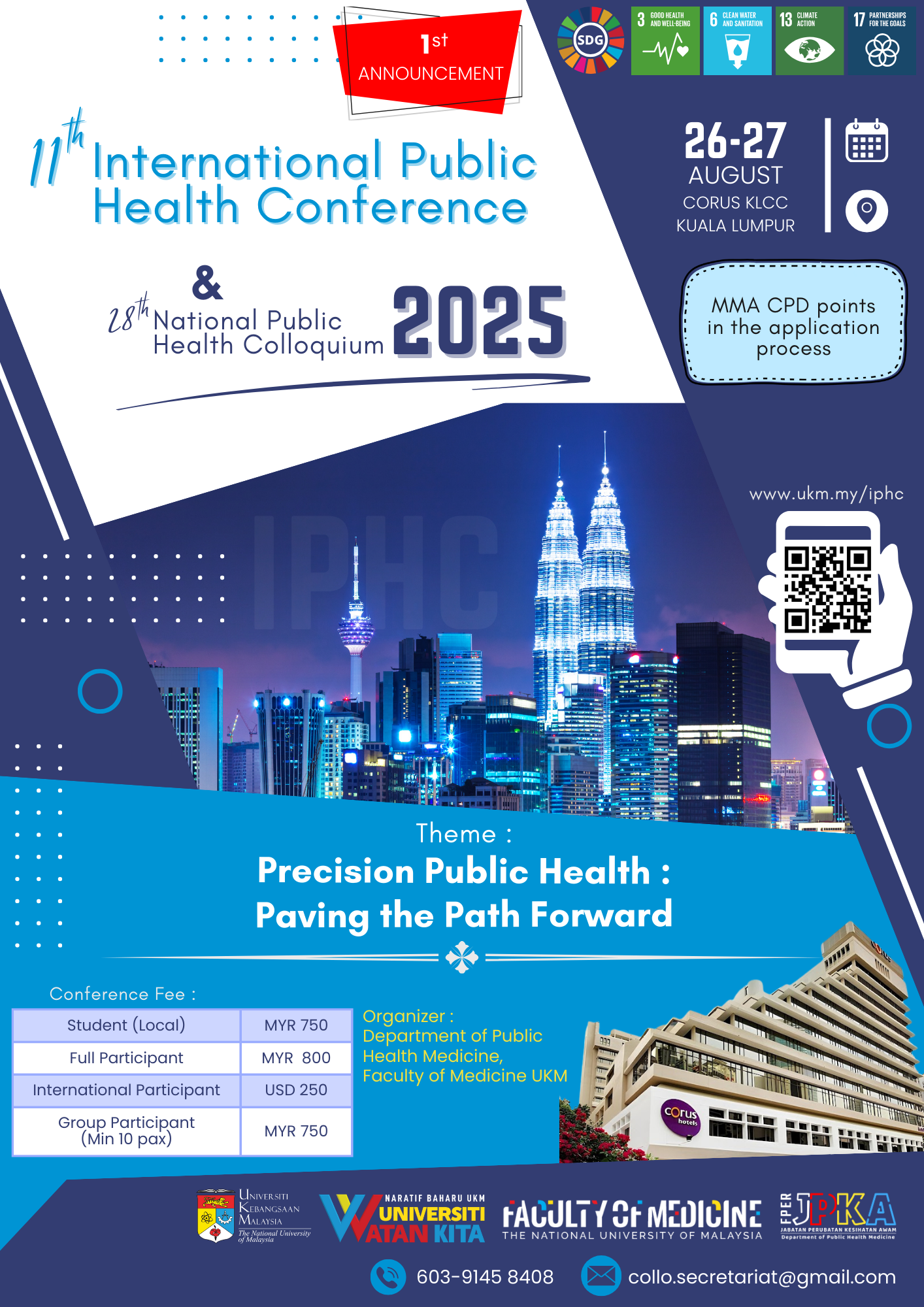Internet Addiction and Its Associated Factors among School-going Adolescents in Malaysia
Abstract
Introduction: Internet usage has changed the way adolescents socialize. This study aims to determine the determinants of internet addiction among school-going adolescents in Malaysia.
Methodology: This study was a cross-sectional study involving 27,455 school-going adolescents from 212 selected schools in Malaysia, as part of the 2017 National Health and Morbidity Survey that implemented a two-stage stratified cluster sampling design. Data collection via a self-administered questionnaire was conducted from March till May 2017.
Results: Overall, 8,049 (29.0%) school-going adolescents had internet addiction. Internet addiction was positively associated with male (odds ratio, OR [95% confidence interval, CI] = 1.20 [1.08,1.34]) compared to female, Chinese ethnicity (1.67 [1.12,2.48]) compared to other ethnicity, feeling loneliness (1.37 [1.20,1.57]) compared to never feel lonely, unable to sleep due to worrying of something (1.40 [1.17,1.67]) compared to able to sleep, insufficient parental supervision (1.30 [1.14,1.48]) compared to sufficient parental supervision, depression (1.67 [1.48,1.89]) compared to no depression, anxiety (2.12 [1.95,2.30]) compared to no anxiety and stress (2.26 [1.96,2.61]) compared to no stress. The odds of having internet addiction increase from Form 2 (1.51 [1.28,1.78]), Form 3 (2.37 [2.01,2.80]), Form 4 (2.60 [1.76,3.85]) to Form 5 adolescents (2.96 [1.98,4.41]) compared to Form 1 adolescents.
Conclusion: Our results suggest that being a male, of Chinese ethnicity, higher form level, feeling loneliness, unable to sleep due to worrying of something, insufficient parental supervision, depression, anxiety and stress were positively associated with internet addiction among school-going adolescents.
Keywords: Internet addiction – public health – adolescents – NHMS - Malaysia
References
Anderson EL, Steen E, Stavropoulos V. Internet use and Problematic Internet Use: A systematic review of longitudinal research trends in adolescence and emergent adulthood. International Journal of Adolescence and Youth. 2017 Oct 2;22(4):430-54.
J Kuss D, D Griffiths M, Karila L, Billieux J. Internet addiction: A systematic review of epidemiological research for the last decade. Current pharmaceutical design. 2014 Aug 1;20(25):4026-52.
Wang Y, Wu AM, Lau JT. The health belief model and number of peers with internet addiction as inter-related factors of Internet addiction among secondary school students in Hong Kong. BMC Public Health. 2016 Dec 1;16(1):272.
Hashim AH, Kaur M, Ng CG. Internet addiction among adolescents in Malaysia: The prevalence and its association with attention deficit hyperactivity disorder (ADHD) symptoms. Malaysian Journal of Psychiatry. 2016 Nov 15;25(1):3-18.
Awaluddin SM, Ibrahim Wong N, Rodzlan Hasani WS, Omar MA, Mohd Yusoff MF, Nik Abd Rashid NR, Aris T. Methodology and Representativeness of the Adolescent Health Survey 2017 in Malaysia. Asia Pacific Journal of Public Health. 2019 Nov;31(8_suppl):8S-17S.
Chong Guan N, Isa SM, Hashim AH, Pillai SK, Harbajan Singh MK. Validity of the Malay version of the Internet Addiction Test: a study on a group of medical students in Malaysia. Asia Pacific Journal of Public Health. 2015 Mar;27(2):NP2210-9.
Gomez F. A guide to the depression, anxiety and stress scale (DASS 21). Central and Eastern Sydney primary health networks. 2016.
Bursac Z, Gauss CH, Williams DK, Hosmer DW. Purposeful selection of variables in logistic regression. Source code for biology and medicine. 2008 Dec 1;3(1):17.
Yadav P, Banwari G, Parmar C, Maniar R. Internet addiction and its correlates among high school students: A preliminary study from Ahmedabad, India. Asian journal of psychiatry. 2013 Dec 1;6(6):500-5.
Lam LT, Peng ZW, Mai JC, Jing J. Factors associated with Internet addiction among adolescents. Cyberpsychology & behavior. 2009 Oct 1;12(5):551-5.
Shaw M, Black DW. Internet addiction. CNS drugs. 2008 May 1;22(5):353-65.
Li X, Li Z, Xie W, Fang D, Shen Y, Cai C, Zhang X, Tian M, Chen H, Zeng J, Xia H. Epidemiological investigation on internet addiction among middle school students in Hefei. Chinese Mental Health Journal. 2006;20(1):51.
Othman Z, Lee CW. Internet addiction and depression among college students in Malaysia. International Medical Journal. 2017 Dec 1;24(6):447-50.
Özdemir Y, Kuzucu Y, Ak Ş. Depression, loneliness and Internet addiction: How important is low self-control?. Computers in Human Behavior. 2014 May 1;34:284-90.
Morahan-Martin J, Schumacher P. Incidence and correlates of pathological Internet use among college students. Computers in human behavior. 2000 Jan 31;16(1):13-29.
Amichai-Hamburger Y, Ben-Artzi E. Loneliness and Internet use. Computers in human behavior. 2003 Jan 1;19(1):71-80.
Carli V, Durkee T, Wasserman D, Hadlaczky G, Despalins R, Kramarz E, Wasserman C, Sarchiapone M, Hoven CW, Brunner R, Kaess M. The association between pathological internet use and comorbid psychopathology: a systematic review. Psychopathology. 2013;46(1):1-3.
Li G, Hou G, Yang D, Jian H, Wang W. Relationship between anxiety, depression, sex, obesity, and internet addiction in Chinese adolescents: A short-term longitudinal study. Addictive Behaviors. 2019 Mar 1;90:421-7.
Panicker J, Sachdev R. Relations among loneliness, depression, anxiety, stress and problematic internet use. International Journal of Research in Applied, Natural and Social Sciences. 2014;2(9):1-0.
Ong SH, Tan YR. Internet addiction in young people. Ann Acad Med Singapore. 2014 Jul 1;43(7):378-82.
Published
How to Cite
Issue
Section
License
IJPHR applies the Creative Commons Attribution (CC BY) license to articles and other works we publish. If you submit your paper for publication by IJPHR, you agree to have the CC BY license applied to your work. Under this Open Access license, you as the author agree that anyone can reuse your article in whole or part for any purpose, for free, even for commercial purposes. Anyone may copy, distribute, or reuse the content as long as the author and original source are properly cited. This facilitates freedom in re-use and also ensures that IJPHR content can be mined without barriers for the needs of research.






